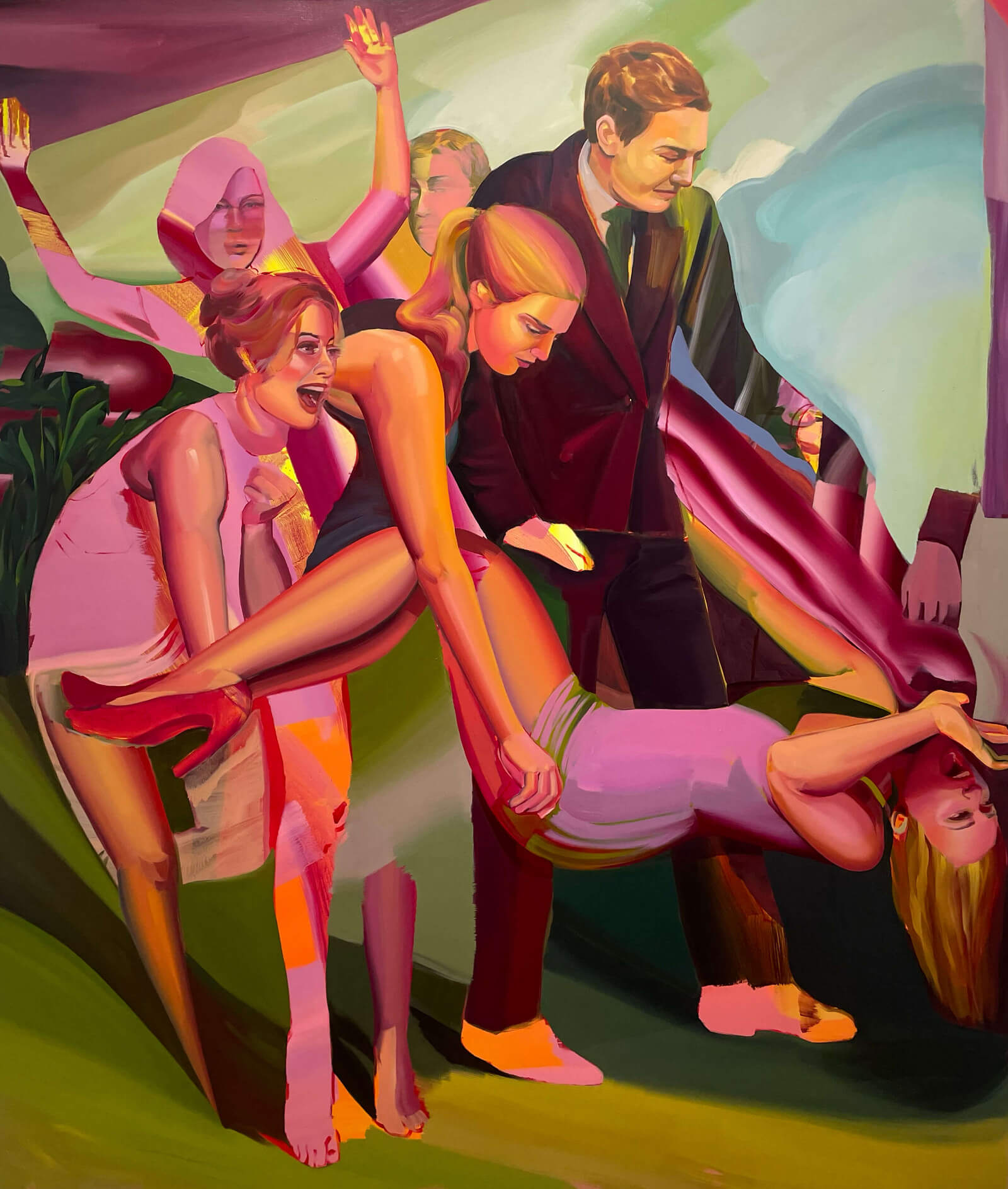Lizzy Lunday
New Myths and Amalgamated Monsters
➝ Download Press Release
In Lizzy Lunday’s new body of work, we encounter figures and compositions that lightly evoke a range of mythological and religious scenes from the history of art. We see glimmers of Caravaggio’s Entombment of Christ (1602) in the reality-show-worthy snafu of Lunday’s painting Slipping. The lithe, serpentine body of Lamia in Isobel Lilian Gloag’s The Kiss of the Enchantress (c. 1890) reappears in the glowing seductress of Lure. But as Lunday notes, these references are more about their recognizability than any specific narrative import. Both historical references and contemporary celebrities function in her paintings as archetypes, which Jung described as recognizable, psychic structures that are consistent across time periods and cultures. Through these new works, Lunday continues exploring her interest in how the imagery of contemporary media merges with our received historical stories to shape our lived experience. In the way that these influences now seem impossible to pull apart, her paintings reflect this condition of glitching between the real and the virtual: foregrounds and backgrounds melt and sweat into each other, bodies are torn apart and reassembled into new mutations, forms seem to deliquesce alongside more tightly rendered ones.
On the Way Out recalls Masaccio’s famous Expulsion from the Garden of Eden (1425), but something is awry. The tortured sense of the human predicament permeating Masaccio’s work is scrubbed clean in Lunday’s version, replaced with a couple walking blithely, under little egoic pressure or infernal guilt. But this recalibration of the Masaccio isn’t as haphazard or arbitrary as might be initially thought. This laissez-faire, celebrity couple is on their way out, as the title suggests, exiting some restaurant or perhaps a television soundstage, returning to their private selves. Like in Masaccio’s Expulsion, represented here is the jarring difference between our private brokenness and who we pretend to be in public. Adam and Eve was the first instantiation of this psychic splitting, and Masaccio’s work captures the exact moment when this distinction became real. We all follow, belatedly, in its wake.
Lunday demythologizes and remythologizes these archetypes and stories, until they sink into images. Her paintings retain the density of these references, but issues new visions from them, shot through with her characteristically oneiric, tastefully perverse visuals. Like in her past works, the figures in these new paintings are also haunted by intimacy’s persistent, tacit failure to stabilize closeness. Is the woman’s gesture in Beheaded tender or territorial? It’s some secret, third, festering thing. In Lunday’s works (as in life), intimacy operates throughout as a problem of definition rather than as a describable fact. As a result, the paintings hold onto an interiority and resistance, and never completely give up their secret (Adorno: ‘one understands something of art, not that one understands art’).
Bodies luxuriate before us (quite literally, as in the beautifully burnishing, Botticellian Clamshell), as if taking pleasure in their own forming, in the hands of Lunday. The figures all thrum with a kind of libidinal, Edenic materialism. Like all great colorists, she paints the world as it swims to her, not ‘as it is,’ but as taking shape and forming. In some of these works, she experiments with thick curtains of red, and in others, beach palettes that skew towards blue, yellow, and pink. Lunday is constantly testing relationships between colors, and freeing color from descriptive duties, from their mortgages and day jobs. To be able to use color in this way is, I think, what it means for painting to truly become its own form of vision.
The best commentary on art, George Steiner says, is other art. Lunday’s work asks the joyous, mysterious questions that follow: How do artworks get inside other artworks? How do artworks recognize each other, despite having been created centuries apart? And what happens when imagery from contemporary pop culture and media intercept these relationships? We rarely know what we want, our desires are opaque to us, but we know that art is a fiction that tells the truth and accumulates its deadly charge through history, cannibalizing older works of art and birthing forth new ones. Like the serpentine female figure that populates some of her new works, the murderous powers of art, and its inability to die off, owe something to its historical againness.
Emily Chun

